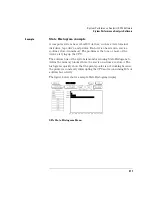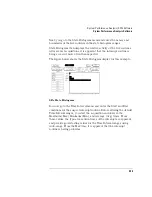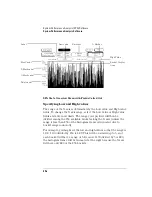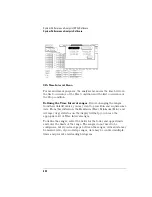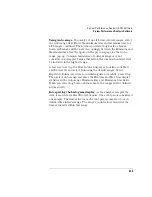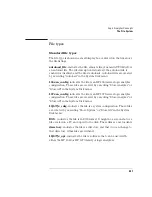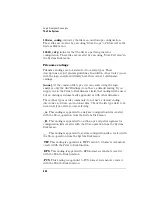
387
System Performance Analysis (SPA) Software
System Performance Analysis Software
The default high and low values represent the full range of the label
you chose. Before changing these values, you may want to run the
acquisition and acquire some data to view activity over the entire range
of the label. You can then zoom in on areas of interest.
You can enter low and high values in binary, octal, decimal,
hexadecimal, ASCII, or symbol.
Interpreting the histogram display
Press the blue shift key and Run to start the State Overview
acquisition. As the data is sampled and sorted, the buckets along the X
axis will accumulate. The relative size of the vertical bars show the
distribution of activity on the label you chose. The analyzer will
continue to sample, sort the data, and update the display until you
press Stop or until you change a display variable.
Max count represents the current upper limit of the Y axis for the
bucket with the greatest number of data samples. Max count for the
limit of the Y axis will increase as the buckets fill with samples.
Read Total count to find the total number of samples taken over the
specified range of the label. This is not affected by the low and high
values.
Using the markers.
To find the number of data samples in any
bucket, select the Xmarker or Omarker field. Turn the knob to move
the marker to the area of interest. Read the X Mark count or O Mark
count values to determine the number of samples in the current
bucket.
As you move either marker across the display, the value in the XMarker
or OMarker pop-up will change. The amount of change of the marker’s
value represents the size of the bucket.
Summary of Contents for 1670E Series
Page 6: ...6 In This Book...
Page 26: ...26 Contents...
Page 27: ...27 Section 1 Logic Analyzer...
Page 28: ...28...
Page 29: ...29 1 Logic Analyzer Overview...
Page 39: ...39 2 Connecting Peripherals...
Page 49: ...49 3 Using the Logic Analyzer...
Page 72: ...72 Using the Logic Analyzer The Inverse Assembler...
Page 73: ...73 4 Using the Trigger Menu...
Page 101: ...101 5 Using the Oscilloscope...
Page 151: ...151 6 Using the Pattern Generator...
Page 199: ...199 7 Triggering Examples...
Page 237: ...237 8 File Management...
Page 249: ...249 9 Logic Analyzer Reference...
Page 360: ...360 Logic Analyzer Reference The Compare Menu...
Page 361: ...361 10 System Performance Analysis SPA Software...
Page 397: ...397 11 Logic Analyzer Concepts...
Page 430: ...430 Logic Analyzer Concepts The Analyzer Hardware Oscilloscope board theory Oscilloscope board...
Page 439: ...439 12 Troubleshooting the Logic Analyzer...
Page 455: ...455 13 Specifications...
Page 471: ...471 14 Operator s Service...
Page 479: ...479 Operator s Service Troubleshooting Troubleshooting Flowchart 2...
Page 491: ...491 Section 2 LAN...
Page 492: ...492...
Page 493: ...493 15 Introducing the LAN Interface...
Page 497: ...497 16 Connecting and Configuring the LAN...
Page 506: ...506 Connecting and Configuring the LAN Connecting and Configuring the LAN...
Page 507: ...507 17 Accessing the Logic Analyzer File System Using the LAN...
Page 515: ...515 18 Using the LAN s X Window Interface...
Page 527: ...527 19 Retrieving and Restoring Data Using the LAN...
Page 539: ...539 20 Programming the Logic Analyzer Using the LAN...
Page 546: ...546 Programming the Logic Analyzer Using the LAN Programming the Logic Analyzer Using the LAN...
Page 547: ...547 21 LAN Concepts...
Page 555: ...555 22 Troubleshooting the LAN Connection...
Page 580: ...580 Troubleshooting the LAN Connection Getting Service Support...
Page 581: ...581 Section 3 Symbol Utility...
Page 582: ...582...
Page 583: ...583 23 Symbol Utility Introduction...
Page 588: ...588 Symbol Utility Introduction Symbol Utility Introduction...
Page 589: ...589 24 Getting Started with the Symbol Utility...
Page 597: ...597 25 Using the Symbol Utility...
Page 609: ...609 26 Symbol Utility Features and Functions...





